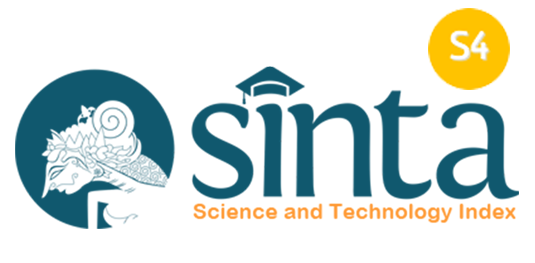Development of blended learning model in numerical method course
Abstract
The aim of this study is to develop a blended learning system with two stay two stray using problem-based learning worksheet. The study is a research and development. The study used four D models covering define, design, development and disseminate stage. Then, the system of the blended learning model and problem-based learning worksheet were validated by two validators with valid criteria and some revisions. For test efficiency, data were processed using a paired sample T-test. The result showed that the average learning outcome improved after the implementation of a blended learning system in which the outcomes of earning significantly improved.
Keywords
Full Text:
PDFReferences
Argaw, A. S., Haile, B. B., Ayalew, B. T., & Kuma, S. G. (2017). The effect of Problem Based Learning (PBL) instruction on students’ motivation and problem solving skills of physics. Eurasia Journal of Mathematics, Science and Technology Education, 13(3), 857–871. https://doi.org/10.12973/eurasia.2017.00647a
Balentyne, P., & Varga, M. A. (2017). Attitudes and achievement in a self-paced blended Mathematics Course. Journal of Online Learning Research, 3(1), 55-72.
Callaghan, M. N., Long, J. J., Van Es, E. A., Reich, S. M., & Rutherford, T. (2018). How teachers integrate a math computer game: Professional development use, teaching practices, and student achievement. Journal of Computer Assisted Learning, 34(1), 10-19.
Chaeruman, U. A. (2017). PEDATI, model desain sistem pembelajaran blended. Jakarta: Direktorat Pembelajaran Kementrian Riset, Teknologi dan Pendidikan Tinggi.
Clements, D. H. (2000). From exercises and tasks to problems and projects: Unique contributions of computers to innovative mathematics education. The Journal of Mathematical Behavior, 19(1), 9-47.
Eser, C., & OzdamliI, F. (2016). Features and characteristics of problem based learning. Cypriot Journal of Educational Sciencies, 11(4), 195–202. https://doi.org/10.18844/cjes.v11i4.1296
Fahsl, A. J. (2007). Mathematics accommodations for all students. Intervention in School and Clinic, 42(4), 198-203.
Farhan, M., & Retnawati, H. (2014). Keefektifan PBL dan IBL ditinjau dari prestasi belajar. Jurnal Riset Pendidikan Matematika, 1(2), 227–240.
Foster, M. E., Anthony, J. L., Clements, D. H., Sarama, J., & Williams, J. M. (2016). Improving mathematics learning of kindergarten students through computer-assisted instruction. Journal for Research in Mathematics Education, 47(3), 206-232.
Hartriani, N., & Veronica, R. B. (2015). Keefektifan model pembelajaran two stay two stray realistic mathematics education. Unnes Journal of Mathematics Education, 4(1), 69–76.
Harun, N. F., Yusof, K. M., Jamaludin, M. Z., & Hassan, S. A. H. S. (2012). Motivation in problem-based learning implementation. Procedia - Social and Behavioral Sciences, 56(Ictlhe), 233–242. https://doi.org/10.1016/j.sbspro.2012.09.650
Helmi, S. A., Yusof, K. M., Phang, F. A., Mohammad, S., & Abu, M. S. (2013). Motivation and learning strategies: Promising outcomes of cooperative problem-based learning. The 4th International Research Symposium on Problem-Based Learning (IRSPBL) 2013 Motivation (pp. 216-221). https://doi.org/10.13140/RG.2.1.1347.7843
Hobri. (2010). Metodologi penelitian pengembangan: Aplikasi pada penelitian pendidikan Indonesia. Jember: Pena Salsabila.
Kristanti, F., Ainy, C., Shoffa, S., Khabibah, S., & Amin, S. M. (2018). Developing creative-problem-solving-based student worksheets for transformation geometry course. International Journal on Teaching and Learning Mathematics, 1(1), 13–23. https://doi.org/10.18860/ijtlm.v1i1.5581
Lambert, R. (2015). Constructing and resisting disability in mathematics classrooms: A case study exploring the impact of different pedagogies. Educational Studies in Mathematics, 89(1), 1-18.
Lapohea, A. Z. (2014). Penerapan Model Pembelajaran Kooperatif Tipe Two Stay Two Stray untuk Meningkatkan Hasil Belajar Siswa pada Materi Logika Matematika. Jurnal Elektronik Pendidikan Matematika Tadulako, 1(2), 133–145.
Lin, Y. W., Tseng, C. L., & Chiang, P. J. (2017). The effect of blended learning in mathematics course. Eurasia Journal of Mathematics, Science and Technology Education, 13(3), 741–770. https://doi.org/10.12973/eurasia.2017.00641a
Maulana, M., & Hidayati, N. A. (2017). Two stay two stray cooperative learning model in mathematics learning outcomes. Jurnal Daya Matematis, 5(3), 354–358. https://doi.org/10.26858/jds.v5i3.4842
Park, S. H., & Ertmer, P. A. (2007). Impact of problem-based learning (PBL) on teachers’ beliefs regarding technology use. Journal of Research on Technology In Education, 40(2), 247-267.
Parta, I. N. (2009). Pengembangan model pembelajaran inquiry untuk penghalusan pengetahuan matematika mahasiswa calon guru melalui pengajuan pertanyaan. Surabaya: Universitas Negeri Surabaya.
Sigurdson, N., & Petersen, A. (2017). Student perspectives on mathematics in computer science. In Proceedings of the 17th Koli Calling International Conference on Computing Education Research (pp. 108-117).
Steele, M. M. (2002). Strategies for helping students who have learning disabilities in mathematics. Mathematics Teaching in the Middle School, 8(3), 140-143.
Tan, C. P., Van der Molen, H. T., & Schmidt, H. G. (2016). To what extent does problem-based learning contribute to students' professional identity development?. Teaching and Teacher Education, 54, 54-64.
Thiagarajan, S., Semmel, D. S., & Semmel, M. I. (1974). Instructional development for training teacher of exceptional children. Reston, VA: Council for Exceptional Children.
Umoh, J. B., & Akpan, E. T. (2014). Challenges of blended e-learning tools in mathematics: Students’ perspectives University of Uyo. Journal of Education and Learning, 3(4), 60-70. https://doi.org/10.5539/jel.v3n4p60
Yudt, K., & Columba, L. (2017). The effects of blended learning in pre-service elementary mathematics teachers' performance and attitude. National Teacher Education Journal, 10(1), 17-25.
DOI: https://doi.org/10.18860/ijtlm.v1i2.5908
Refbacks
- There are currently no refbacks.
Copyright (c) 2020 International Journal on Teaching and Learning Mathematics

This work is licensed under a Creative Commons Attribution-NonCommercial-ShareAlike 4.0 International License.
Indexed by :
.png)
.jpg)
.png)

.jpg)



